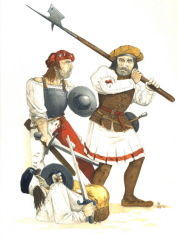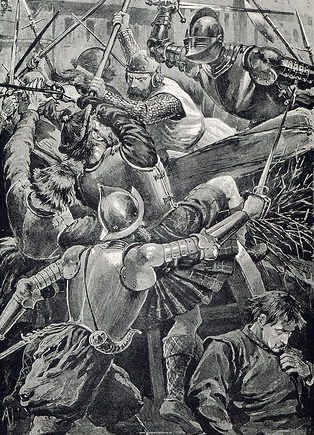Cleanse the Causeway

In 1520 Arran had tried in vain to dissuade Margaret from returning to Angus and now took it upon himself to prevent Angus securing the King. He had ridden to Edinburgh at the head of 500 hundred armed men with the objective of seizing Angus. This was all to be under the pretence of calling a convention to talk over their differences. According to Robert Lindsay of Pitscottie in his history of the period, written in 1575, each man was:
‘well accompanied and arrayed with jack and speir’
Finding Angus in the city, Arran ordered the city gates to be locked but was dismayed to find that Angus also had 500 of his followers at hand . With the tension mounting the citizens prepared themselves for the inevitable confrontation. To make matters worse for Arran, the guildsmen of Edinburgh held a grudge against him since, as Provost, he had sided with the Leithians against them in a dispute about a recent arrival of a cargo of wood on a Dutch ship. They were soon to be given the opportunity to show their displeasure.
There followed a tense stand off as both sides looked to gain advantage and neither wanted to be seen as the instigator of violence. Arran’s uncle, Gawain Douglas, Archbishop of Dunkeld was placed in the role of peacekeeper and negotiator mainly due to his pious and caring nature. He called upon Archbishop James Beaton, latterly a Hamilton supporter and great friend of Gawain, to remonstrate with his allies and as a fellow churchmen and official representative of the law, sue for a peaceful settlement. They met at Blackfriars Wynd to discuss a suitable course of action.
However Beaton had resigned himself to confrontation and met Douglas wearing a mail haulberk under his robes. He was at once quizzed by Douglas about the imminent debacle and declared ‘upon my conscience I know nothing of this.’ And as to show his honour he struck his breast with his fist causing the chainmail to rattle. Douglas, now aware that Beaton was armoured ready for the fight, sourly remarked ‘My Lord your conscience clatters! ’
Realising both sides were set on a fight, Douglas found his nephew to warn of the Hamiltons’ intent and then withdrew to his chapel to pray. Angus went on the offensive, arraying his supporters at the Netherbow gate. Many of the Hamiltons had taken to their lodgings and as they slept Angus had his men blockade the yetts and alleyways, hemming the residence in. Undoubtedly the vengeful guildsmen acted as ‘agente provocateurs’, ensuring the Hamiltons were kept duly occupied.
It was to fall upon Patrick Hamilton of Kingscavil, the fourth bastard child of Arran, to trigger the action. Patrick had won notoriety in a duel with a French mercenary, John Coupante, some years earlier in Edinburgh castle, in which despite being unhorsed he had ended up forcing the Frenchman to yield. Renowned for his hot temper and love of a good fight he was to be the spark in the powder keg.
Spurred on by Sir James Hamilton of Finnart to take action, Patrick declared ‘I shall fight today where you shall not be seen ’ and made his way onto the High Street in a furious rage accompanied by his friend the Maister of Montgomerie. They ran straight into Angus and in a fit of anger started a street brawl. The cries from the street alerted the sleeping Hamiltons who tumbled out after them in an attempted rescue but instead found themselves trapped in the side streets where they were set upon by the Douglas contingent.
George Buchanan, a contemporary chronicler writing in his Scottish history describes the action:
‘immediately he [Angus] and his party, having buckled on their armour seized upon the broadest street in all the town. He had about fourscore in his train, but all stout and resolute men and of known valour. They divided and posted themselves in the most convenient places, and so set upon their enemies as they came out of several narrow alleys at once; first they slew, and drove the rest back headlong, tumbling one upon another in great confusion’
The scene was horrific as in each road and alleyway men set about each other with bill and spear, sword and knife, the sound of harquebus fire resounding across the city. Douglas’s men resorted to ransacking known Hamilton safe houses, setting them alight in an attempt to smoke out the poor unfortunates. In the panic and chaos it was virtually impossible to prove allegiance to either faction before being put to the sword. Many fled the city to escape the fighting, others battened down their doors and hoped to be spared.
Pitscottie reckoned over 300 Hamiltons were killed, Buchanan states 72, in the fighting that followed in the alleyways and streets all the way up what is now the Royal Mile. Arran and his son only made their escape by seizing a packhorse carrying coal in from Leith and fording the shallows of the Nor Loch. Beaton had sought sanctuary behind the high altar in Blackfriars but was betrayed and pulled out into the street by the mob. He was only saved from murder by the intervention of Gawain who declared it a sin to put a hand on a consecrated Bishop. Angus sent out trumpeters to issue an ultimatum to all remaining Hamilton supporters to leave the city and Buchanan notes that one body of over 800 horsemen took advantage of this offer and left the city in disgrace. By nightfall the Douglases had control of the city and the castle.
James and Margaret remained oblivious of the whole affair, the King playing in the grounds of the castle throughout the fighting. The locals christened the event the ‘ Clense the Calsey’ most likely after the battle cry of the Douglas faction .

